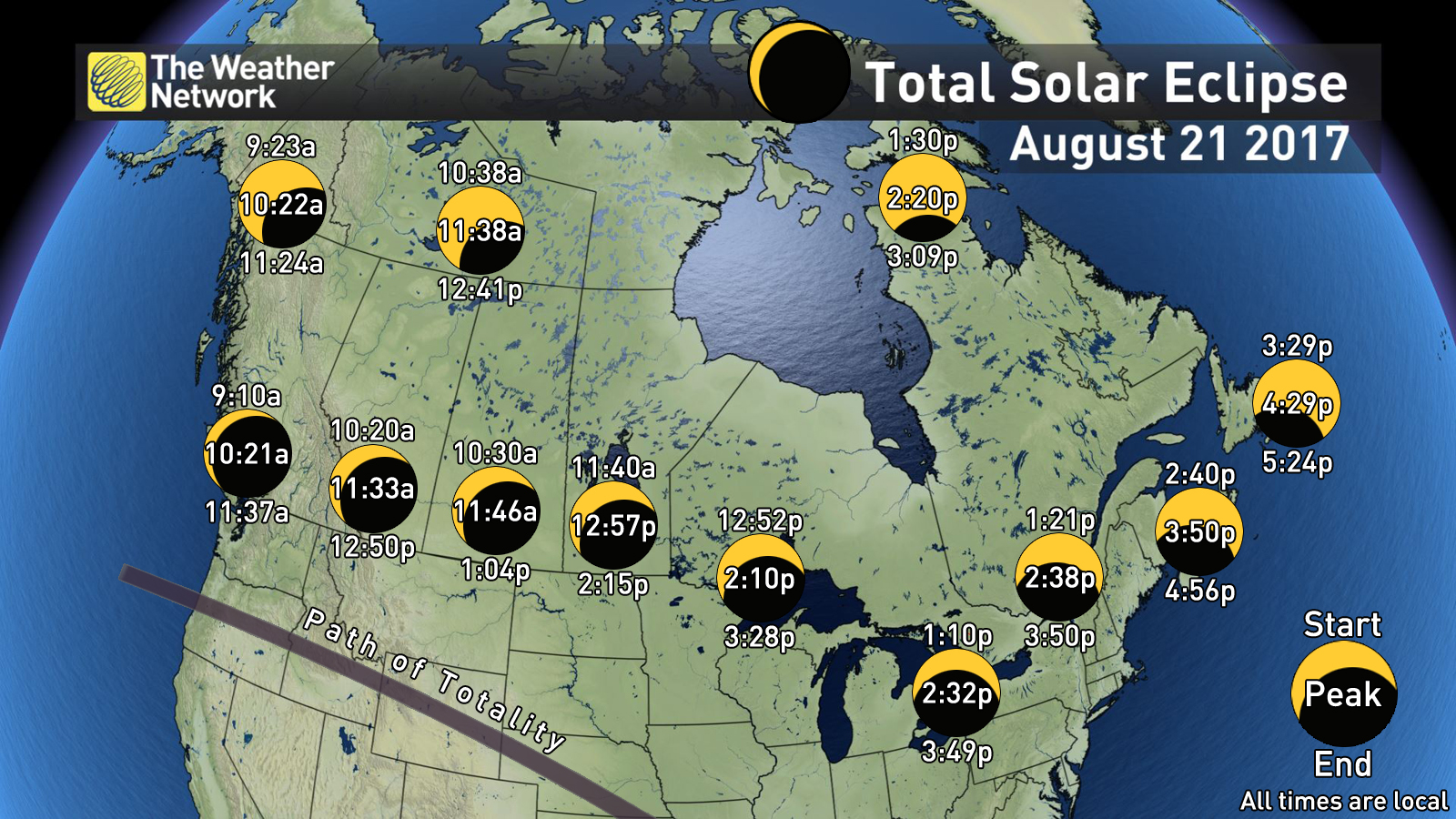Clear? Cloudy? What will Canada see for the Solar Eclipse?
Meteorologist/Science Writer
Monday, August 21, 2017, 1:24 PM - The August 21 Solar Eclipse should be an amazing experience for all who see it. Who sees it will depend largely upon the weather, though, so what will Canada's skies be like that day? Here's what we know so far.
Too cloudy to see where you are? Check out our live stream here until 4 p.m. EDT.
The current sky forecast, as of Monday morning, for between 12 p.m. EDT and 4 p.m. EDT, is shown below.
The timing of the animation covers roughly the full duration of the eclipse, from when it first becomes visible for those on the west coast, until it ends for those on the east coast. See the exact timing of the eclipse, for your location, on the map below.
Check the cloud conditions over your region, however, be aware that much of the cloud shown in the animation is high cirrus-type cloud, which may not completely block out the eclipse, and the amount of cloud may be slightly over-emphasized.
What if it's cloudy?
If it happens to be completely overcast in your location during the eclipse, the only way you're going to directly view it is if you go online and check out livestream of the event (like ours!).
Depending on where you live, though, even under an overcast sky, you may still notice it getting darker as the eclipse approaches its peak for your location. The closer you are to the path of totality, the more the Sun will be covered by the Moon, and the easier it will be to notice the dimming light. Thus, those areas farther to the west, especially in southern Alberta and southern British Columbia, are most favourable for seeing this effect.
CLICK THE MAP BELOW TO ENLARGE

The above map shows the start, peak and end times of the eclipse, across the country. The times listed are set to the local time zone of the area the icon is over, and each icon shows what the Sun will look like at maximum eclipse for each location.
If you happen to be along the path of totality and the sky is overcast when the Moon's shadow crosses your location, the light won't just dim. According to the Eclipse2017.org blog, "If the sky is completely overcast, it will get VERY dark - pitch black, in fact, to the point where it will be tricky to walk around."
The trickier situation will be if it is mostly cloudy or even partly cloudy overhead.
If there are only a few small breaks in the clouds, it's going to take good timing in order to see the eclipse when it peeks through, or the ability to be mobile, to get somewhere where the skies may be more clear. Even with partly cloudy skies, a cumulus cloud in the wrong place at the wrong time, or even a string of them, may spoil the view for a significant amount of the event. One particular cloud getting in the way during the exact moment of totality, for anyone along that path, could put a damper on the entire experience.
In Canada, where we'll only see a partial solar eclipse for the entire duration, this won't matter quite as much. If you're not right on the path of totality, the moment of maximum eclipse doesn't have as dramatic an effect, so there's less of a chance of one cloud spoiling things.
Safety First!
If it happens to be cloudy where you are, but the Sun is still peeking through those clouds, be very careful about whether or not you are wearing your eclipse glasses. This is especially true here in Canada, where it is unsafe to watch any part of the eclipse without having your eclipse glasses on (or #14 welders glass, or by using a pinhole projector). Remember that it is only safe to view the eclipse directly, without any protection, if you are along the path of totality, and only when the Moon is completely covering the Sun.
It may be tempting to take the glasses off, to just view the eclipse using the clouds as a filter. While clouds do act as a filter for the sunlight, however, it is probably best to keep the glasses on. If the Sun were to unexpectedly shine through a clear patch in the clouds, and your eyes are not shielded against its light and radiation, even momentary exposure could cause some amount of solar retinopathy - a sunburn on your retinas. It usually takes minutes of exposure to cause long-term or permanent damage, but it's really not worth taking the risk.
![]() CHECK OUT OUR OTHER ECLIPSE CONTENT:
CHECK OUT OUR OTHER ECLIPSE CONTENT:
Want to take Eclipse pics with your cellphone? Here's how
How to safely view the August 2017 Total Solar Eclipse
Whatever you do, don't look (and 2 more eclipse travel tips)
Total solar eclipse headlines summer astronomy in 2017
Even if it is cloudy...
If your skies turn out to be overcast on the day of the eclipse, there's still ways that you can take part in the event.
Definitely tune in to The Weather Network, on TV and on the web, as we broadcast a live-stream of the event from the path of totality, but there are also opportunities to perform some cool science during the eclipse.
NASA is looking for citizen scientists, to take temperature measurements during the eclipse, to see how the Moon's shadow (even away from the path of totality) affects temperature and weather here on Earth.
Teaser image courtesy: Nilfanion/Wikimedia Commons
Sources: Marshall Shepherd/Forbes | Eclipse2017.org | NASA | NASA Earth Observatory



